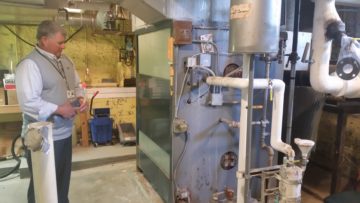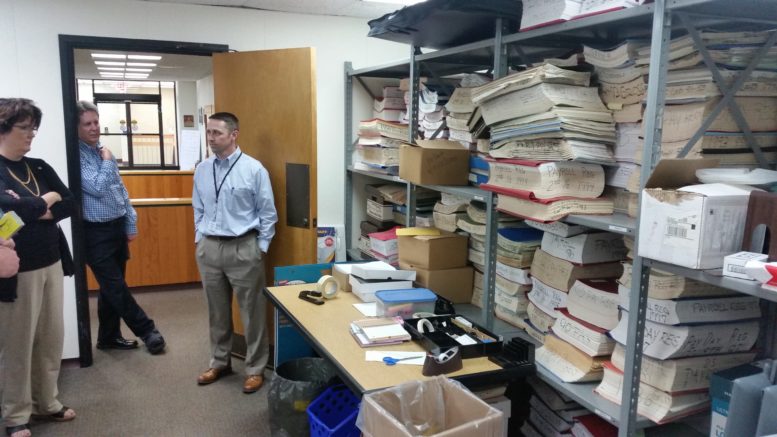By JAN LARSON McLAUGHLIN
BG Independent News
The city administration building is a square peg trying to fit in a round hole. No, it’s more like several square pegs trying to squeeze into that circular space.
The building, at 304 N. Church St., started its life more than a century ago as a school, then was molded into a library, and in 1976 became the city administration building. So while its age poses some problems, the bigger issue is that the building was designed for educating children, not for administering city services.
The result is a 17,000 square foot building with cramped offices, maze-like spaces and cobbled together technology.
For years now, city leaders have discussed the possibility of a different municipal building, with the debate continuing on whether it should be a new building or a renovated existing site. Most seem to favor the offices staying downtown.
But one conclusion that doesn’t get much debate is the need for different space.
First, there’s the age issue.
About 20 noisy air handlers are crammed between the original ceilings and the drop ceilings. Ultraviolet lights and air purifiers are used to reduce the mold problem. “It’s good mold, but mold none the less,” said Assistant Municipal Administrator Joe Fawcett said.
Workers often find a powdery white coating from the drop ceilings on their desks, according to Public Works Director Brian Craft.
“I thought it was snowing in my office the other day,” Fawcett said.
Across the hall in the personnel and clerk of council office, sloping floors cause a problem. One employee couldn’t use a plastic sheet under her office chair because of the uneven floor. “She’d roll backward” and had to constantly pull herself back to her desk, said Personnel Director Barb Ford.
And power access is less than ideal, with masses of cords plugged into inconvenient locations.

Brian Craft looks at “Big Bertha,” the old boiler.
The old construction is not energy efficient, with the south side sweltering in the afternoon sun while the north side of the building is freezing, Craft said.
“There are literally days when the air conditioning is running when the boiler is on,” he said.
And speaking of the boiler, “Big Bertha,” as she is nicknamed, is “horribly inefficient,” Craft said. He likened the 60-year-old boiler to a Model T car. And like other areas of the city building, officials are reluctant to invest money in updates if the building will be scrapped for another site.
“It’s like peeling the onion back,” Fawcett said. “Once you start, where do you stop?”
Next, there’s the space issue. The lack of enough square footage for the 50-plus city employees in the building is one problem, but it’s magnified by the poor design that may have worked for the original school and the subsequent library – but does not work for city offices, Fawcett said.
“The functionality of the space is just not usable,” he said. “Where we want space, we don’t have it. Where we don’t want space, we have it.”

Brian Craft and Joe Fawcett talk next to octagonal cutout on third floor.
Fawcett doesn’t have to look far from his office for the first example – the big octagonal space cut out in the middle of the second and third floors. While the hole down to the basement floor may have been visually appealing in a past use, it is just wasted space now. And the dumb waiter that may have been useful for moving books is now just a nuisance. The restrooms are cramped and just barely pass muster for handicapped accessibility.
Storage space is in high demand, Craft said, squeezing into a narrow closet that is the washroom, attic access and mechanical access.
The council chambers is small, with the fire code allowing a maximum of 66 people. That means several times a year, citizens attending meetings have to stand in the hallway since the room is overflowing.
“We’re supposed to be accessible to the public,” but it’s difficult with the space constraints, Fawcett said.
Public accessibility is also tested in the basement, where the income tax, utilities business office and technology offices are located. Though the income tax and utilities offices are spaces with heavy citizen traffic, they are not the easiest to find, with residents having to navigate a mix of up and down steps to just reach the basement.
“This is where it gets interesting,” Fawcett said as he walked down to the bottom floor of the building. Not only is the space less than ideal for customers, it’s also lacking for city employees, “unless you like working in a closet,” Fawcett said.

David McDonald works in cramped IT room.
The technology department is a maze of rooms, with one of the smallest housing the brains of the building – servers with information on email, telephones, utilities, finances, taxes and police data. “Everything is stacked one of top of each other,” said IT Director David McDonald. He has to squeeze sideways to get to the back of the servers and the spaghetti stack of wires.
McDonald said he is “extremely lucky” to have a window in his office. The employee next door to McDonald set claim to his space by using yellow tape to delineate where his office space began and where the walkway between offices ends.
Many walkways are so thin that two people cannot pass, requiring a type of “shell game” to navigate the mazes.
Storage space is in great demand, with boxes and files filling any vacant space, behind doors, on floors, stacked high on shelves. “That’s prime real estate,” Fawcett said, pointing to an empty shelf.
This time of year is particularly taxing for the tax department, with papers piled high on desks.
“We still have to have things on paper,” Tax Commissioner Rob Wright explained. The space does not allow for cubicles or any type of taxpayer privacy, he said. “I don’t have a choice.”
The aging structure has not been fitted with a sprinkler system, since the cost would be prohibitive, Fawcett and Craft said. There are “pull stations” which alert people to evacuate the building and notify the fire department of a potential fire.
“But if a fire happened at 3 in the morning, nobody is here, it will burn to the ground,” Craft said.
The last study to determine just how much space is needed for a city administrative building should be updated since the city has fewer employees than when the last space utilization review was done, Fawcett said.
With the building bursting at the seams, Fawcett and Craft are hopeful that a suitable home can be found for city offices – for citizens and employees.

